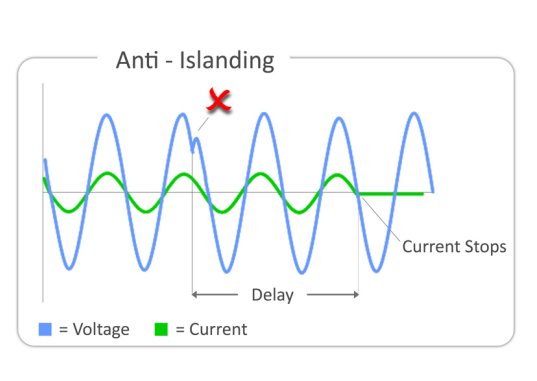One of the main reasons people invest in solar power is to gain energy independence from the utility grid. However, adding a solar panel system doesn’t necessarily mean that your home is immune to power outages or blackouts. During such an event, your grid-tied system might be turned off automatically to protect the grid from “solar islanding”. To keep generating power, you need to become your solar energy island.
Understanding how your solar panel system works—especially when it comes to safeguarding against power outages—is crucial for taking full advantage of its benefits. A typical grid-tied solar panel system consists of solar panels, an inverter, and a connection to the electrical grid. When the sun shines on the solar panels, they convert sunlight into direct current (DC) electricity. The inverter then converts the DC electricity into alternating current (AC) electricity, which is compatible with your home’s electrical system and the grid.
During normal operation, if the solar panel system generates more electricity than your home needs, the excess electricity is sent back to the grid. Conversely, if your home needs more electricity than the solar panels generate, it pulls electricity from the grid. This two-way flow of electricity allows you to save money by reducing your reliance on the grid and even earn credits for the excess electricity you contribute to the grid.
However, when the grid experiences a power outage or blackout, a protection mechanism known as anti-islanding kicks in. This mechanism is designed to protect utility repair workers from dangerous power backflows when they are working on the grid. To prevent potential harm, the grid-tied inverter is programmed to automatically shut off when the grid goes down, effectively isolating your home from the grid.
While this safety feature ensures the protection of utility workers, it also means that your solar panel system won’t generate power during a power outage. To ensure you will have electricity during such an event, you can consider two main options: adding batteries to your solar panel system or investing in a hybrid solar system.
Battery storage solutions, such as solar batteries, allow you to store excess electricity generated by your solar panels and use it during power outages. When the grid goes down, your system automatically switches to using the stored energy from the batteries, providing a reliable backup power source. This option offers you the most energy independence and reliability during blackouts, as you become completely self-sufficient.
On the other hand, a hybrid solar system combines the benefits of grid-tied and off-grid solar systems. It includes both a grid-tied inverter and a battery storage system. During normal operation, your solar panel system generates electricity and reduces your reliance on the grid. When the grid goes down, the hybrid system’s inverter automatically switches to off-grid mode, allowing you to still use the electricity generated by the solar panels and stored in the batteries. This option provides a balance between energy independence and continued connection to the grid.
In conclusion, investing in solar power is a great way to gain energy independence from the utility grid. However, to ensure that your solar panel system continues to generate power during power outages, you need to become your solar energy island. Adding battery storage solutions or opting for a hybrid solar system can provide you with a reliable backup power source, effectively making your home self-sufficient. Consider your options and assess your energy needs to make an informed decision that aligns with your goals of energy independence and reliability.
Post time: Jul-21-2023
